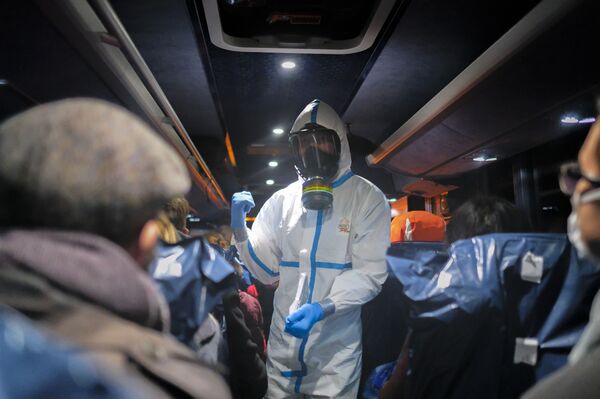It has been several months since the first coronavirus case was registered in China, with the disease later going on to infect some 80,000 people in the country and kill 3,267. Beijing is now reporting fewer than 100 new cases daily, while some Western countries are registering around 5,000 new cases every day and are attempting to bring this number down by any means necessary - including by shutting down public events and places, businesses, and putting entire cities affected by COVID-19 under quarantine.
Although many of these countries are essentially reliving the toughest moments of the pandemic that China experienced when it was the only severely affected country, there is one major difference - the way the Western media cover it.
'Ineffective' Quarantine
One of the main topics of the media's criticism of China's response to the novel coronavirus threat was its move to entirely lock down Wuhan city - one of the country’s industrial centres and the epicentre of the COVID-19 pandemic.
Many Western journalists, as well as experts interviewed by them, fervently argued that the measure was ineffective. The online media outlet Wired stated that Beijing was "nuts" for trying to cordon off a "megacity" and "central transportation hub" like Wuhan. The Washington Post suggested that the Chinese government could "hope only to diminish" the virus' spread.

The magazine Foreign Policy opined that the quarantine was unlikely to work, but could definitely create major problems, such as the need to feed and supply the city's population with other goods. CNN [TK3] cited an expert on global health law who claimed that there is "little evidence of [the quarantine's] effectiveness" since people tend to "get out", insisting that the measure "could backfire, from a public health, social, human rights perspective".
But as the virus has spread beyond China due to the Lunar New Year travelling season and prolonged incubation period of COVID-19, other countries that have witnessed outbreaks of the disease have chosen to adopt the supposedly "ineffective" quarantine method that was utilised by Beijing as one of the main measures to contain the infection and limit its impact. But few outlets characterised it this way when the disease came knocking on the door of their own countries.
'Draconian Measures'
Another widespread point of criticism in the Western media of China's actions was its rigorous attempt to control the flow of infected residents. Vox and The Washington Post called the lockdown of an entire city to prevent the spread of the disease, which by then was killing between 2% and 3% of those infected, "draconian". The Washington Post also suggested that the real mortality rate could actually be much lower and if so, then the closure of the entire city would be "foolish" and only add to "interrupted commerce, public dissonance and panic".

Meanwhile, the CBC went even further, citing the director of the Centre for the History of Medicine, Howard Markel, who claimed that a quarantine is "like an atomic bomb for health options" and might do more harm than good.
However, closing off entire cities in Italy or calling for the military's help in New York was somehow not considered overkill in the Western media. The CBC called the decision to lock down New York, Illinois, and California the "most sweeping efforts yet to contain the coronavirus" undertaken by authorities. The Washington Post didn't call the decision to temporarily halt business activities in the Big Apple "draconian" either. Vox noted the military's input when it came to helping the major city, but suggested that it could do more.
Alleged Human Rights Violations and Government's Ineffectiveness
Beijing's methods of keeping track of people's movements around the country also drew a lot of attention in the Western media. CNN described China's approach as "a sophisticated authoritarian playbook" used to "enforce quarantines and lockdowns across the country". The broadcaster also emphasised the country's state-promoted videos showing drones monitoring citizens who violate the quarantine and do not follow basic procedures to protect their health - such as not wearing protective masks or washing their hands.

The Diplomat online magazine described one grim story, which could not be verified, of a Chinese citizen who visited Wuhan and was put under 24-hour observation for coronavirus symptoms. The media outlet slammed Beijing's "rigorous system of social control" that was allegedly set in motion to track and monitor the country's 1.4 billion people, each of whom could be carrying the disease.
Few news outlets, however, made note of the apparent effectiveness of the Chinese government's methods when the country reported zero local infection cases, as opposed to the hundreds and thousands being registered in other nations on a daily basis. While The New York Times was among the few to point out this fact, it was quick to backtrack, claiming that the "price in human trauma and economic loss was severe" when it came to the apparent victory in the fight against the coronavirus.
Bloomberg, in turn, chose to emphasise the alleged ineffectiveness of the Chinese authorities' actions in regards to containing and curbing the outbreak, calling them "a tale of bureaucratic miscues, a health-care system unequipped for sudden crises and food industry in dire need of reform". Yet when other countries were facing shortages of basic things such as hospital beds, as was the case in South Korea, the media instead chose to praise how quickly the problem was solved. News about the first hospital, which was built in China's Wuhan in just a week, to treat the growing number of COVID-19 patients was, in turn, taken rather with a pinch of salt.
Few Western mainstream media outlets chose to blame governments when bed shortages occurred in New York, San Francisco, and in the UK, despite the fact that unlike China, they had time to prepare.






